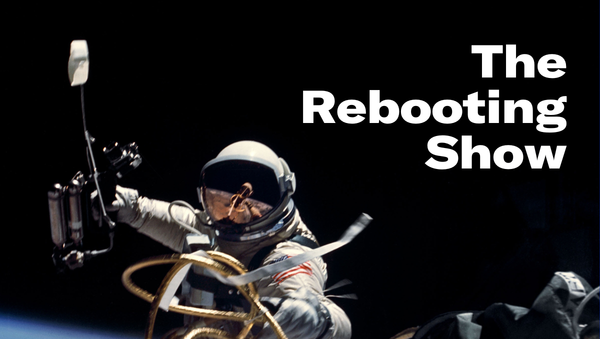Human ad products
Primary-engagement media
I decided to mix up the days for this newsletter and the format. You’ll now get The Rebooting twice a week, Tuesday and Thursday. The Tuesday email will continue with a new format that is a mix of topics, along with highlights from the podcast. I think this is a better approach than my original podcast-centric approach. But let me know your thoughts: bmorrissey@gmail.com.

Human ad products
Building a good media product is endlessly difficult, particularly when it comes to advertising. Math gives way to physics when ad products are built, as the complexities get ramped up, trying to satisfy financial goals, performance, audience needs, the overall brand mission, not to mention the challenge of balancing unique ad products with repeatable (and high-margin) ad products. Too often, that’s resulted in an adversarial approach to monetization that seems to operate in a parallel universe to the the stated ethos of the brand. If you’re going to claim to be high end, it’s hard to then turn to bottom-of-the-barrel monetization methods.
The shift to primary-engagement media is an opportunity to rethink monetization products. The success of newsletters and podcasts ad products has mostly been due to ignoring the typical monetization methods of other digital media. Running banner ads in email newsletters doesn’t work as well as hand-crafted ads in the voice of the publication, particularly if delivered by an individual. The same holds true for a personal publishing medium like podcasting, which has long relied on host reads. These are more human ad products, playing into the “casualness” that’s eating the world.
Litquidity, which is aiming to more than triple the $1 million in revenue it reached last year, has rolled out an interesting new product in which it will co-host earnings calls for companies on Twitter spaces. Litquidity began as a popular finance meme account, and has since expanded into a daily email newsletter with more than 120,000 subscribers, a podcast, mech operation and investment portfolio. Litquidity has signed up RCI Hospitality, operator of dozens of nightclubs and strip clubs, to host RCI’s investor call on Twitter Spaces. For RCI, this is an opportunity to reach a new class of retail investor and younger finance pros who aren’t the type to dial into the normally dull investor calls where analysts love to repeat “great quarter, guys.”
Brian Hanly, CEO of Bullish Studio, which works with Litquidity on growth and monetization, estimated investor relations to be a $1 billion-$3 billion market, with 4,200 public companies spending on average $800,000 on IR. Those budgets are an attractive target, particularly for smaller public companies that do not generate the equity analyst coverage of more high profile companies. RJI, for instance, has just three equity analysts covering it.
“Their last earnings call had 100 people,” said Mark Moran, head of growth at Litquidity who will host the RJI call. “One of my tweets about this [program] reached 200,000. We can confidently say we’ll get more than 100 people.”


House of Kaizen brings together leading minds and proven practices to help subscription product teams get ahead, fast. Their SubscriptionWorks program is designed to inspire and upskill your internal team with training, events, best practices and on-call consultation that addresses your current opportunities. House of Kaizen collaborates to optimize the entire subscriber journey, from marketing to product experiences, for net growth and sustained recurring revenue.
On Wednesday, May 4, TJ Huttner from Audible.com will be sharing his experience in a members-only AMA. Join TJ and executives from the world’s leading subscription brands for these events and more as a member, and mention that you’re from The Rebooting for special price consideration.

HBR’s thriving publishing business
Harvard Business Review is a “surreptitious media company.” The publishing arm of Harvard Business Review has a thriving publishing arm that has attracted 320,000 paid subscriptions. This week, I spoke with Nini Diana, the director of consumer revenue at HBR, for the latest episode of The Rebooting Show. Some takeaways:
- Pricing is a moving target. HBR charges $10-15 per month for a subscription, less than many Substack newsletters. Nini said the price point allows for HBR to reach a far broader swathe of people than a high price geared to only the top executives.
- Churn is a reality. With different types of subscriptions, different groups of subscribers have different behavior patterns. Some churn at a higher rate, requiring internal expectations management.
- Paid acquisition isn’t a priority. Many publishers rely on blasting out introductory offers. HBR is more judicious, focusing instead on converting its known users to paying subscribers. Most of its advertising is focused on retargeting existing users to move them closer to subscribing.
Check out the full podcast on Apple or Spotify. Thanks to House of Kaizen for its support.

The CNN+ disaster
It’s no exaggeration to say that the CNN+ debacle will become a business-school case study. This weekend, the “behind-the-scenes” stories came fast and furious, a sure sign of a bloody corporate knife fight. While Quibi failed because the programming simply wasn’t very good, CNN+ barely existed long enough for its programming to warrant a grade. To me, the real lessons are about corporate strategy and culture.
- Ego is a massive liability. I can remember writing a story about Sprite starting a social network and wondering why a massive corporation like Coca-Cola could ever allow itself to believe this would work. What I realized is many executives are so insular that they start to believe their own bullshit. That pretty clearly happened here, as CNN executives fell prey to hubris and believing their ambient media was essential.
- Numbers are often used to back up strategy, not drive it. Everyone likes to claim to be “data-driven,” but the reality is many corporate types seek out data to back up their strategy, not vice versa. Discovery executives knew they didn’t want CNN+ as a standalone service and matched the data to give a reason to snuffing it out.
- Set the right expectations. When the data was pulled, Warnermedia and Discovery executives saw different realities. For Warnermedia executives championing CNN+, attracting 150,000 paid subscriptions in a month was an encouraging start that augured well as it put the service ahead of the debuts of The New York Times. Discovery saw it as evidence CNN+ was DOA.
- Testing hypotheses beats big bets. There’s a knee-jerk impulse to praise the attempt rather than engage in a dog pile, especially when many undeserving people lost jobs. CNN+, however, was clearly poorly planned and executed. Putting $1 billion behind this effort wasn’t bold, it was dumb and driven more by ego than audience need.
- The rebundling is on. The challenges facing streaming services, as highlighted by Netflix, is there are simply too many of them. Niche streaming products will continue in high-passion areas, but it’s hard to understand if CNN+ would ever develop the kind of habit-forming programming that would attract a large enough, and loyal enough, subscriber base. In the big leagues of streaming, news is a side dish, not a main.

Audience-first publishing
Last week, I wrote about the need to rethink the current approach to paywalls. Cambell Rawlins, director of commercial strategy at Politico, shared their view:
“IMO, media companies that launch with an audience-first strategy – building for an audience who rely on that content/information to do their jobs – are best positioned for continued success. This was Politico's strategy from the start, but it’s also exciting to see so many new media brands emerge over the past few years (Protocol, Blockworks, Endpoints News, Charter and many Substack newsletters like The Rebooting) who launched with a similar approach.”

Recommendations
To see where markets are going, follow the capital, but financial and human. Former Bleacher Report COO Alex Vargas is joining Recurrent Ventures as COO. Recurrent is building an interesting portfolio of focused media brands across lifestyle, home and tech categories.
The advantages of legacy institutions over upstarts, including individuals, is being evaporated. Platforms and tools have made key aspects of media, from distribution to monetization, less of a competitive advantage premised on scale. That’s also happening, with acceleration, on the creation and packaging side, as tools like Canva, Descript, Riverside and new tools like AI image generator DALL-E 2 give everyone the tools of high-end production. That will erase the “costly signals” used by many institutional brands to command premium pricing.
The audience numbers many publishers tout aren’t what they seem. That’s because most of their traffic comes through search and social platforms, not people who are seeking them out. No surprise then that most of the traffic to UK regional publishers isn’t actually local. Much of that is tied to business model incentives that leads publishers to pile on traffic no matter whether it’s from the actual target audience – and then hope advertisers don’t poke around log files much.
The Netflix saga is a good reminder that at the end of the day what matters most is great content. I never understood the framing of Netflix as a technology company – what company doesn’t use data and tech infrastructure? – and it obscured how Netflix didn’t bend the logic that’s always driven Hollywood: hits. When Netflix has must-see programming, it thrives. Quality always trumps quantity.
I’m heading to London and Munich next month to speak at a pair of events. On May 19, I’ll be speaking at the PPA Festival in London and then again on May 21 at DLD in Munich. Let me know if you’ll be at both or would like to connect: bmorrissey@gmail.com.

Thanks for reading. If you have a chance, please forward this newsletter to colleagues you believe would find it valuable. Also, if you’re interested in sponsoring The Rebooting and reaching top executives from established and new publishing companies, check out the sales kit and get in touch: bmorrissey@gmail.com.




